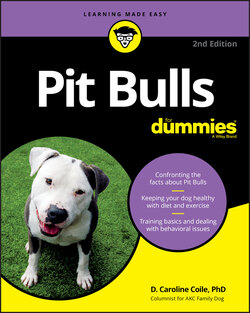Читать книгу Pit Bulls For Dummies - D. Caroline Coile - Страница 12
Creating Canine Gladiators
ОглавлениеDogs and humans around the world have long shared a special relationship — a relationship originally based on function. Early dogs who proved least useful — or who were too wild, skittish, or dumb — probably ended up in the cave man’s pot, but the most helpful dogs (who were good at sounding alarms at intruders or at chasing down game) lived to produce others like them. Eventually, breed forerunners were created by breeding the best guards to the best guards and the best hunters to the best hunters. Of these, some strains proved to be especially brave and tough — valuable traits in a rough world.
Of course, these strains weren’t really breeds. Few cave men had American Kennel Club or United Kennel Club papers for their dogs, so pure breeding wasn’t terribly important to them. Still, with time the strains of dogs became more and more specialized. By classical Greek times, large fierce dogs called Molossians were so valued that Phoenician traders used them as bartering items. Because of this practice, the Molossian type was distributed along Phoenician shipping routes, some of which included stops in ancient Britain. The Molossians who ended up in Britain became further specialized and gave rise to the Mastiff family of dogs.
In Britain, Mastiffs were perfected as war dogs. When the Romans invaded Britain, they were so impressed by the Mastiff’s warring ability that they brought some back to Rome. Romans valued entertainment, and the courageous dogs became infamous as gladiators who fought humans, bears, lions, bulls, and even each other in Rome’s great Coliseum.
Rome was not, however, the only civilization to revel in blood sports. The British, too, placed high value on contests that featured animals fighting to the death. The spectacle of a dog killing a bull was the highest entertainment that most small villages could offer its poor inhabitants. But this kind of entertainment spanned all classes: By the 16th century, bull-, bear-, and even horse-baiting provided the finale for a royal evening of entertainment (for an explanation of bull-baiting, see the sidebar “Bull-baiting”). In the 17th century, the King even appointed a Master of the King’s Games of Bears, Bulls, and Dogs.
The dogs’ owners won prizes for their animals’ spectacular performances, and the progeny of famous or particularly game dogs (meaning those dogs who refuse to quit the task at hand despite overwhelming adversity) were sought after and capable of bringing high prices. As distasteful as it sounds, these dogs produced the never-say-die stock from which today’s Pit Bull claims her heritage.
An end to legal blood sports in England finally came about in 1835, but that only pushed the fans and gamblers to conduct covert matches. Staging a clandestine bull-baiting would have been difficult, but scheduling a dogfight in a barn, cellar, or back room without being discovered was quite simple.
Dog fighting favored a slightly smaller, more agile gladiator than the dogs who were adept at baiting larger animals. Most historians believe that the stocky bull-baiting dogs were crossed with the swift and agile terriers of the time to produce the aptly named Bull and Terrier, a relatively small, smart, agile, tough, and strong game dog the likes of which had never been seen before. Other breed historians contend that no such cross was made and point out that the Bulldog of the time, the Bullenbeisser, was, in fact, so similar to the modern Pit Bull that it was simply a matter of selecting the most successful fighters. Whatever the recipe, it worked.
